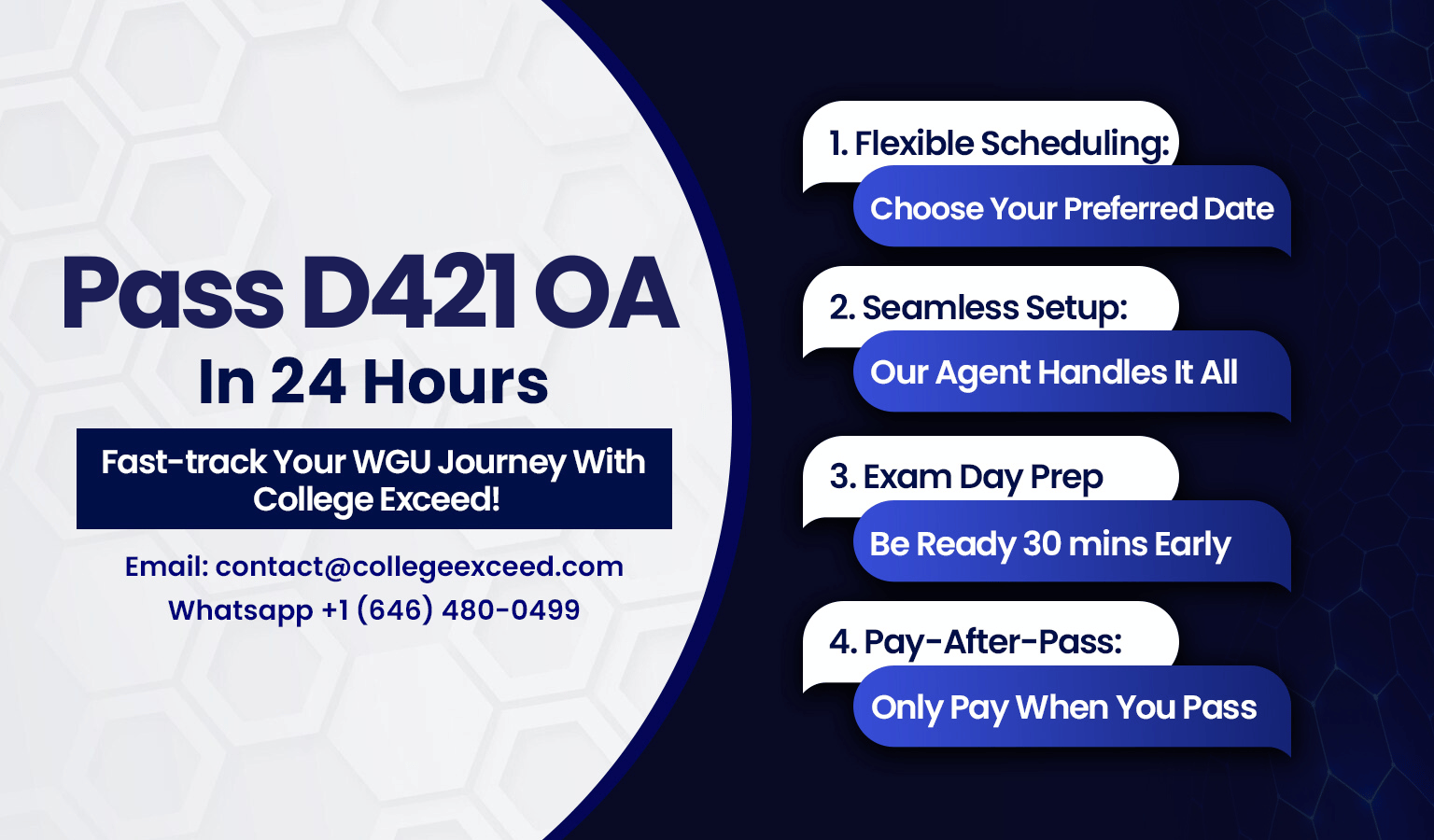Welcome to your ultimate guide to acing Discrete Math: Functions and Relations WGU D421 can be obtained at WGU! Just in case you are feeling slightly daunted by this module, which is quite okay, to be honest, This class may appear to be a bit tough if you are not a mathematics guru, but believe me, there are ways you can easily get through it. In this article, you will learn all the essentials about this module: what it is, what to prepare for, how to prepare, and what help is out there for the asking.
Here’s what we’ll cover in this article:
- What to Expect from the Module – Understand the key concepts and topics that will be covered, and learn which areas are crucial for your exams.
- Study Guide to Pass the OA – A week-by-week planner that will bring you through all the information in the course and ensure its successful digestion.
- External Resources to Help You Study – Find out more about the tools available on the internet for effective learning of complex topics.
- Key Tips to Prepare and Ace the OA – A deep dive into the most important topics, with comparisons, examples, and easy explanations.
- FAQ – FAQ section with answers to questions that students may have about the course.
- Conclusion – A summary of last advice and words of encouragement to help you get through this module untroubled.
Be you an absolute beginner or a student with your hands stuck deep in the spinning, glittering pile of new knowledge, this guide is designed to help you navigate the process as seamlessly as possible. Let’s dive in!
...
What to Expect in WGU D421 Discrete Math: Functions and Relations📖
Welcome to Discrete Mathematics: Functions and Relations WGU D421 which is the basic course that is specifically important in laying down the mathematical background needed for systems networking and other higher-level computer science courses. This module is intended to prepare you with practical tools for comprehending and dealing with abstract discrete structures which are inevitable in systems networking, data structures, and algorithms among other areas.
In this course, you will look at set theory where you will learn issues such as unions, intersections, and Cartesian products, all of which are fundamental to knowing how data is structured and processed in computers. In this section, set theory constitutes the main material from which many other sections of mathematics and computer science will be built, so mastering this will become helpful in the future.
You will also solve finite sequences and series that are useful to analyze the behavior of algorithms and how information processes within systems. Familiarizing yourself with these quantities will enable you to envisage how functions operate on various domains, and possible detections given specific inputs, a key goal of computational study.
Another key area you’ll explore is relations, which are used to describe and understand the connections between different elements in a set. Relations are foundational in understanding databases, networking, and even the behavior of certain algorithms. You’ll learn how to represent and analyze these relationships using graphs, an invaluable tool in computer science.
As a learner, you will employ a learning resource on zyBooks that combines lectures with topics and assignments. To get the most out of this resource the author encourages the reader to participate in the Participation Activities, Challenge Activities, and Lesson Exercises. All these are intended to help you consolidate what has been covered and prepare you for the final ‘objective type’ test.
When you are done with this course, you shall be able to understand set theory, sequences, series, and relations all of which are important in computer science. This is where one scholar will be tested and evaluated on competency after the scholar has gone through a series of activities, it is therefore advisable to be keen and practice most of the time.
A Study Guide for D421 Discrete Math: Functions and Relations📝
To excel in Discrete Mathematics: Functions and Relations (D421) and successfully pass the Objective Assessment (OA), it’s crucial to follow a structured approach that ensures you cover all the necessary material. Here’s a step-by-step guide to help you navigate through the course efficiently:
Step 1: Read the Zybook
Begin by thoroughly reading the zyBook provided for this course. The zyBook is an interactive learning resource that covers all the key concepts you’ll need to understand. It’s packed with instructional content, Participation Activities, Challenge Activities, and Lesson Exercises designed to reinforce your learning. As you go through each section, make sure to actively engage with these activities. This will help you solidify your understanding of the material and prepare you for more challenging problems later on. Don’t rush this step—take your time to absorb the information and practice with the exercises provided.
Step 2: Go Through All the Worksheets in the Course Tips
Next, focus on the Worksheets in the Course Tips. These worksheets are specifically designed to target the core concepts and problem types you’ll encounter in the OA. They often provide practical examples and additional practice problems that can help clarify any concepts you find difficult while reading the zyBook. Completing these worksheets will give you a stronger grasp of the material and build your confidence as you move forward. It’s a good idea to review any mistakes and revisit the related sections in the zyBook to ensure you fully understand the topics.
Step 3: Do the Pre-A
The Pre-Assessment (PA) is the first quiz to take before attempting the final assessment of the course. The PA is a good way to measure your degree of preparedness for the OA. It addresses the same concepts as the OA: and can be of the same difficulty level or a different one, although it can have different sub-topics. Work through the problems like a practice exam—attempt to put yourself into the examination period by setting a timer on and cheating. After you have completed the PA, scrutinize the outcomes that have been arrived at. Review the week’s materials and if there are areas that could have been done well, identify those as weak zones and go over them in the zyBook and worksheets. This step plays an important role in sorting out all issues and what you want to be defended so that you are well-prepared for the OA.
Step 4: Do the OA
The OA is the final step after the zyBook, worksheets, and PA, and should be attempted once you are familiar with the content of the course. The OA is the final step in this course, where your competency in Discrete Mathematics: Aim: The assessment of Function and Relations. When coming to the final exam one should remain as calm and rational as possible and use all the knowledge that has been accumulated during the course. As we said before, the OA is a behavioral exam, it is expected that you demonstrate what you have learned. So, the best thing is for you to give your best.
Here are the steps to follow in order to get you ready for the successful completion of the OA: Which always means making sure you do some careful and diligent preparation, and then sticking to those efforts and practicing regularly.
...
Essential Resources for WGU D421 Discrete Math: Functions and Relations📂
Here are some free online resources to help you grasp the tricky concepts in Discrete Mathematics: Functions and Relations (D421):
- Kimberly Brehm on YouTube
Kimberly Brehm offers clear and concise videos on Discrete Math topics, making complex ideas easy to understand.
- Maths and Stats on YouTube
Check out the Maths and Stats channel for detailed explanations, especially on functions, relations, and graph theory.
- Khan Academy
Khan Academy offers comprehensive lessons and practice exercises, particularly useful for sequences and series.
- Compscilib Cheat Sheet
The Compscilib Discrete Math Cheat Sheet provides quick, easy-to-understand summaries of key topics like graph theory.
These resources are great for reinforcing your learning and getting extra practice.
...
D421 OA Success Strategies for Discrete Math: Functions and Relations 👨🏻🏫
Preparing for the Objective Assessment (OA) in Discrete Mathematics: Functions and Relations (D421) looks tricky but do not let this examine you, there are tips that will help you when you are facing the exam. Here are some tips and tricks to help you succeed:
- Leverage Your Resources
If you find yourself struggling with any concepts, don’t hesitate to email questions to the math team or book an appointment with them. The math team is there to help you, and using their expertise can make a big difference in your understanding. Also, make use of the ‘Need Help’ feature in zyBooks—it’s a quick way to get clarification on tricky topics right when you need it.
- Use a Whiteboard During the OA
Many students find that having a whiteboard during the OA is incredibly helpful. You can quickly jot down formulas, work through problems, and keep your thoughts organized. It’s also a good idea to have a calculator on hand, just in case you need to double-check any calculations.
- Practice with the Pre-Assessment (PA)
The Pre-Assessment (PA) is a great way to gauge your readiness for the OA. It covers the same topics and at the same level of difficulty as the OA, though the specific questions might differ. For example, if the PA includes a question on reflexive relationships, the OA might instead focus on transitive relationships. The key is that the depth of knowledge required remains the same, so performing well on the PA is a strong indicator that you’re ready for the OA.
- Focus on Memorization
While the concepts in this course are relatively simple, there’s a lot to memorize. Make sure to spend time reviewing key definitions, properties, and relationships so that they’re fresh in your mind on exam day. Flashcards or summary sheets can be helpful tools for this.
- Understand the Exam Structure
The OA comprises 32 multiple-choice questions; the test must be completed within 120 minutes. It would help if you knew this ahead of time, so you know how to time yourself during the examination. Due to the online proctoring of the exam, the computer should be set in a quiet and noise-free area so that the candidate can attend only the exam.
Applying these tips and using all possible helpful resources, the student will be ready to pass the OA and get the best score.
...
FAQs for D421 Discrete Math: Functions and Relations❓
- What should I do if I don’t understand a topic?
You are welcome to submit questions to the math team through email, ask for help through the “Need Help” button in zyBooks, or schedule a meeting with the math team. They are standing by with you!
- How should I prepare for the OA?
Start by thoroughly reading the zyBook, completing all the worksheets, and taking the Pre-Assessment (PA). The PA is an excellent indicator of your readiness for the OA. Focus on understanding the concepts, and consider using a whiteboard during the OA to work through problems.
- What is the format of the OA?
The OA comprises thirty-two multiple-choice questions for which you will be given one hundred and twenty minutes to complete. The exam is online proctored, therefore there must be no noise and no disturbances during the examination.
- How do I know if I’m ready to take the OA?
If you perform well on the PA and feel confident with the material, you’re likely ready for the OA. Remember, the PA covers topics at the same depth as the OA, so use it as a benchmark for your readiness.
- Can I use a calculator during the OA?
Yes, having a calculator on hand during the OA is allowed and can help double-check calculations.
- What’s the best way to memorize the material?
Since there is a lot to learn by heart, the incorporation of the flashcard or summary sheet is very efficient. By putting the subject into operation every once in a while, the information should be routinely reprocessed in your brain.
...
Conclusion: Mastering Functions and Relations in Discrete Math 📄
Passing Discrete Mathematics: Functions and Relations (D421) may look very daunting at the initial stage, but by following the right parameters and tools one is able to deliver the best. Begin with reading through the zyBook, using the math team in case of any questions, and taking the Pre-Assessment Test. Take items such as a whiteboard, and calculator to the OA because they can be of so much help during the exam.
The ideas you are going to meet are rather clear and understandable; however, they demand repetitions, so do not neglect this activity. Implying my answer to what has been said in this guide and adhering to the focus applied, one will be ready to advance through the OA and triumph in this course.
Good luck, and please understand, it is practice makes perfect in practicing with these sets of equations!






